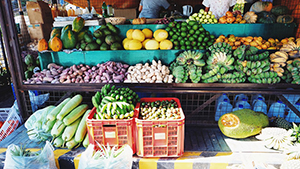Editor’s Note: Every year, 40 or so students in the MIT Center for Transportation & Logistics' (MIT CTL) Master of Supply Chain Management (SCM) program complete one-year thesis research projects. The students are early-career business professionals from multiple countries with 2 to 10 years of experience in the industry. The research projects are sponsored by and carried out in collaboration with multinational corporations. Joint teams of company people, MIT SCM students, and MIT CTL faculty work on real-world problems chosen by sponsor companies. In this series, we summarize a selection of the latest SCM research.
Designing supply routes is a challenge for any large retailer, particularly under conditions of rapid growth. Faced with significant uncertainty, many untestable assumptions, and limited resources, choosing a network design can feel more like a shot in the dark than a rigorous, informed decision.
Working with a national retailer on its rapidly growing fresh food business, we developed a light-weight model to evaluate the costs and generate insights into the trade-offs between multiple supply network designs under a variety of future business conditions.
A Shot in the Dark
This retailer expects significant growth in its nascent fresh food business, which includes high-perishable items such as sandwiches, salads, and parfaits shipped in totes. Currently, the company receives freshly made product from the supplier at a distribution center, where it is immediately consolidated with non-perishable items and sent to stores.
The system works with relatively low fresh food volumes; however, the retailer expects demand to increase from 3x to 5x current levels. As demand increases, the company is concerned about the adequacy of this network design in every region. Will consolidation continue to make sense? Will shipping directly to stores increase freshness, and at what cost? Should the supplier be co-located with the distribution center?
Bringing Light to the Situation
Optimization methods cannot provide useful insights given the numerous questions and unknowns about future conditions. Moreover, the company needs some initial guidance before it channels heavier investments into detailed research.
In collaboration with the retailer, we created four candidate supply routes to move fresh foods from a Northeastern supplier to regional stores: (1) dedicated supplier-to-store, (2) supplier and distribution center co-located for consolidated shipping, (3) supplier to city cross dock for van routing, and (4) distribution center to supplier for pickup while on route to stores.
Utilizing approximation methods, we developed a light-weight model to enable rapid cost estimate for each candidate design, including the current route.
Aligning the Sights
The analysis validated the current network to be about $3.15 per tote. The model was then applied across all candidate route designs, showing the delivery costs under existing demand would range from $1.75-$7.03 per tote, narrowing to $1.62-$2.68 as demand increases to 5x current levels. Co-location was consistently the least costly option, offering estimated savings of $120k per year under current demand, and increasing to $360k per year as demand increases. Aside from co-location, the current design remains the most cost-effective until 3.8x demand levels, when it is matched by Zone Skip and Direct-to-Store scenarios.
The model was also used to test the sensitivity of each networks' costs to a variety of assumptions about future business conditions. This process generated important additional insights into route designs:
• Demand must increase before dedicated fresh food networks are viable due to the lack of economies of scale with shipping fresh food as a stand-alone product.
• Tote fill-rates significantly impact costs (can drive savings ranging from 17% to 43%)
• Vehicle selection is an important driver of cost and delivery time, allowing for savings of 15%-34%, or yielding savings of six hours for most network designs.
• Production policies influence freshness. A 12-hour shift in production policy will accelerate delivery to customers by 24 hours at an approximated cost of $0.01-$0.02 per item.
• Delivery interval shifts from 2 days to 3 days with a maximum 12-hour shelf-life extension, offers cost savings to offset the premium of more rapid deliveries.
Take Aim and Fire
These insights allow the large retailer to understand the key delivery cost drivers for its nascent fresh food business. The work also enables the retailer to hone further research as well as investment strategies pertaining to which route designs will best serve the company and its customers as demand soars.
Moreover, the model and approach can be applied in other regions and by other organizations attempting to efficiently evaluate route designs for any rapidly growing businesses, particularly for highly perishable items.
The SCM thesis authored Cyril Khamsi and Veronica Stolear evaluated efficient supply routes for highly-perishable foods under conditions of rapid growth. The sponsor was a major retailer, and the project was supervised by Dr. Chris Caplice, Executive Director, MIT Center for Transportation & Logistics.
For more information on the research please contact Dr. Chris Caplice at [email protected].
SC
MR


Latest Supply Chain News
Latest Podcast

 Explore
Explore
Latest Supply Chain News
- Strengthening customer fulfillment: Building a strategic stakeholder network
- The hard job of teaching soft skills
- Trump picks former Wisconsin congressman Sean Duffy for DOT secretary
- Made in Mexico, manufactured by China
- Retail sales see gains in October, reports Commerce and NRF
- Balancing green and speed: Home delivery insights from the pandemic era
- More latest news
Latest Resources

Subscribe

Supply Chain Management Review delivers the best industry content.

Editors’ Picks




